If you are going to do a proper job of maintaining your airplane, you will need some tools that don’t have much use outside of aviation. You don’t necessarily need to buy all of these tools, but you will need to have access to them one way or another. Often you can make an informal deal with some of your airport buddies to each buy a few of the special tools and share them. Or you do as I do and be the guy who has all the tools and lends them to his friends. If you are that guy, be sure to keep track of who has what so you can get them back when you need them.
Some tools are such that you shouldn’t buy them until a problem arises that demands their use. Get the basic tools early on and wait on the rest.
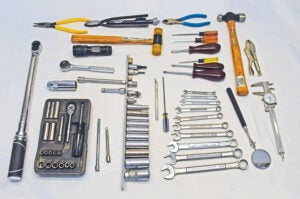
General Tools
Everyone needs a pair of safety wire pliers, a torque wrench and an assortment of general mechanic’s tools such as sockets, wrenches, pliers and the like. If you built your plane, you already have most if not all of these essential tools. If you didn’t build your plane, you might have to invest in some.
A good selection of general tools might include these items: 1/4-inch-drive socket set, 3/8-inch-drive socket set, combination wrench set through 3/4 inch (all of these in fractions of an inch dimensions), an aviation spark plug socket, select metric combination wrenches (10mm, 12mm, etc.), an assortment of extensions for socket sets, a plastic hammer and a ball-peen hammer, a small flashlight and inspection mirror, an X-Acto knife, a magnet with an extendable handle, a pair of precision calipers, a 3/32-inch Allen wrench for removing radios and an assortment of pliers and screwdrivers. You may need others that meet the specific needs of your airplane.
When it comes to tools, it pays to get good ones but not go crazy. Most of my tools are Craftsman, and they have served me well for a very long time. This is not to disparage the premium brands such as Snap-on or Matco, but they get pretty pricey and don’t necessarily provide greater value. Harbor Freight has tools at the other end of the price spectrum, many of which represent great value, but you need to use some discretion about what you buy there. The consensus is that occasional-use or odd-sized tools from Harbor Freight are fine, but your everyday tools are worth an extra investment.
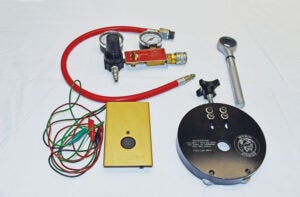
Engine Maintenance Tools
When we start talking about engine maintenance, we get to the need for special airplane tools. Here are the primary tools you will need, assuming you are not talking about taking the engine apart. The basic differential compression tester that will work on Lycoming or Rotax engines costs $106 from Aircraft Spruce. It includes an 18mm insert and a 12mm insert. If you are using automotive spark plugs, common with E-MAG and Light Speed ignition systems, you will need to get a 14mm insert that you can pick up at any auto parts store. You should perform a differential compression test yearly or whenever you suspect cylinder or valve problems. Of course, you will also need an air compressor to provide the compressed air needed to make the tester work.
You will also need a wrench to remove your oil filter. You can just use a 1-inch combination wrench that you pick up at Harbor Freight, or you can get a special oil filter torque wrench for $82. I suggest saving your money and going with the combination wrench.
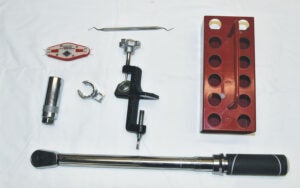
While we are on the subject of oil changes, you will want to get or borrow an oil filter cutter so you can cut your filter open and inspect it for metal particles at each oil change. The best one is by Airwolf, and it costs $135. As a mechanic friend once told me, buy the best and cry only once. You are going to need this tool at least twice a year, so just do it.
Another once-a-year tool is the magneto synchronizer or buzz box. It is needed to check or set the timing of your magnetos. I have the least expensive one Aircraft Spruce sells at a bit under $70. It has worked well for many years. If you have electronic ignition, you will need to consult with that vendor for tool recommendations.
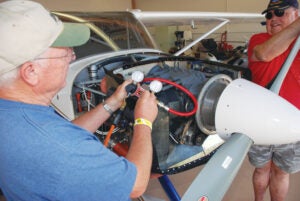
Again, for engines using magnetos and aviation spark plugs, you will need a few special spark plug tools. A spark plug gapping tool and gap gauge are required, and a dental pick to get lead balls out of spark plugs is highly recommended, as is a spark plug caddy. You already have a torque wrench, but you will need to add an aviation spark plug socket. With many RV-style baffle systems, it is also convenient to have a 7/8-inch crow’s foot to remove and tighten the rear plugs that can be hard to reach with the baffles in place. Anti-seize is also a good idea to prevent spark plugs from sticking in their threads.
The last item for engine work is a bucket with a lid that can catch your drain oil and hold it until you can dump it at a recycling center, which can be found at most airports.
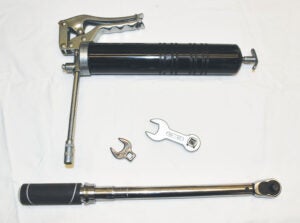
Propeller Tools
If you have a fixed-pitch prop, you only need a torque wrench to tighten the prop bolts and safety wire pliers to secure the bolts. If you have a wood prop, you will need these twice a year to make sure your prop bolts are tight. If you have a constant-speed propeller, you will need a Hartzell prop tool or some other crow’s foot attachment to access the bolts. If you do not have a reason to remove the prop, you don’t need the tool. Just wait to buy it until the need arises. With a constant-speed prop, you will also need a grease gun to lube the prop hub at the time of your condition inspection. Be sure to load it with an approved grease for your prop.
To repair nicks and scratches on the prop blades’ leading edges, you will need a file with a rounded face and a flat face. You will also need sandpaper of various grits and some paint.
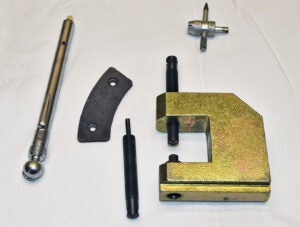
Tire, Wheel and Brake Tools
To replace worn brake pads, you will need a drill and a brake rivet tool. There is no need to buy these things until you need them, but when you do, you need to either buy or borrow the right tools. The rivet tool is less than $30 to buy, so it doesn’t inflict much financial pain. On the other hand, you will only need it every few years, so it is nice to share one among your airport buddies.
Wheels ordinarily don’t need any maintenance other than cleaning, but any nick in the face or edge of the wheel should be dressed out with a file to prevent cracking. Badly scarred wheels should be replaced.
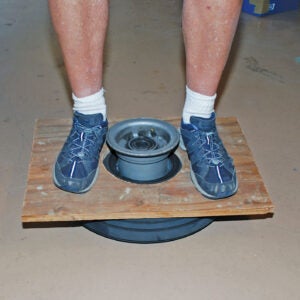
To change a tire, you will need a tool to remove the valve stem, an air pressure gauge made for tires and a bead breaker to free the tire from the wheel. I bought a bead breaker for about $150 several years ago, but I never use it. I recommend making one from a piece of plywood about two feet square with a hole cut in the middle to clear the wheel’s diameter. Place the plywood on the tire and step on it to break the tire loose. It works like a charm.
Calipers are nice to have to check the thickness of the rotors and brake pads to see if it is time to replace them.
Lastly, you will need a jack that can safely lift your airplane and some wood blocks or jack stands that you can use to support the plane after jacking it up. Never work on anything that is only supported by a jack if it is at all possible. Jacks fail, and when they do, people can get hurt.
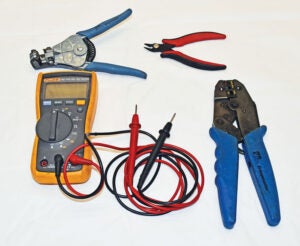
Electrical Tools
Your most important electrical tool is a good volt-ohm meter or multimeter that can accurately measure to 0.1 ohms and 0.1 volts. This is your primary diagnostic tool when sorting out electrical problems such as hard starting. My favorite is the Fluke 115, but the Fluke 101 ESP will do the job and only costs $53 from Amazon. There are cheaper meters, but it is hard to beat Fluke quality. If you don’t know how to use a multimeter, there are some EAA Hints for Homebuilders videos that can help and many YouTube videos that are mainly focused on automotive applications but can still be useful.
If you need to perform electrical repairs, you will likely need a good crimper, some side-cutting pliers and a wire stripper. If you need to buy these tools, be sure that they are sized for the gauge of wire you will be working with. I suggest you wait to buy them until you need them.
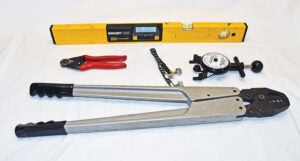
Airframe Tools
If you fly any of the Van’s RV-series airplanes, you don’t need much in the way of special airframe tools, but if you have a plane that uses cables for controls, you will need some special tools if major changes to the rigging are required. Since these tasks are not part of standard maintenance, there is no need to get these tools until the need arises, and even then, borrowing is a much-preferred option. Some of these tools include a cable gauge for $189, a Nicopress swaging tool for $299 and a turnbuckle tool for $32.50. A Smart Level can be very helpful for determining control travel, even for RV owners, if the need should arise. They start at around $50. A cable cutter is also nice to have but not mandatory. As with electrical tools, there is no need to buy these unless a problem arises that requires them.
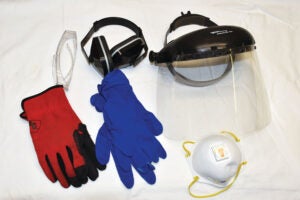
Personal Protective Equipment
It should go without saying that if you are exposed to personal risks while performing aircraft maintenance, you should take steps to prevent injury to yourself and anyone who may be helping you. When handling chemicals, resins or grease, you should wear nitrile or latex gloves. When working with liquids, a pair of safety glasses is a very good idea. When grinding, a face shield is much better than safety glasses. In addition to safety glasses, a dust mask is mandatory when cutting or sanding, especially fiberglass or carbon fiber. Work gloves can come in handy when working on a hot engine. And, last but not least, ear protection should be worn whenever loud noises are present such as when riveting or grinding.
This safety stuff is mostly common sense. It isn’t expensive to protect yourself, and it can save you from a serious injury, an injury that might jeopardize your flying dreams.
Conclusion
You need tools to perform routine maintenance tasks. If you don’t have them, get them. Don’t be that guy who always has to borrow everything. However, if you have some friends around the airport, there is nothing wrong with making informal deals to share items you only use once or twice a year. One guy can buy the compression tester, another can buy the buzz box. However, you do it, use the proper tool for the job at hand.














Buy the oil filter torque wrench; it is incredibly convenient to use and ensures that the filter is properly tightened.
For a Hartzell propeller, it is better to buy a proper torque wrench, rather than using a crowsfoot.
Snap On has an appropriate torque wrench which has its’ own open end wrench for the nuts on a Hartzell.
Bought mine at Oshkosh at a discount from the Snap On guy who attends.
AME’s have borrowed my propeller torque wrench cause they didn’t have one!!
I would add one more, I use my Vividia Borescope for many things besides just looking in the engine. I do consider a borescope inspection of the cylinder walls , valves and seats as important as the pressure test but being able to look under floor boards or inside walls is very handy. I have an small ebay laptop I use it with.
I recommend the borescope and have myself. I just decided to not include it with basic tools.
Oil cutter filters are so useful
I got mine from longacreracing and it cost me 70-80 bucks. Easy to use. Has not failed me so far. These are so useful when I am looking for metal flakes or failures. Enjaging article. Thanks!
I’ve got a great list for Oshkosh now…thanks Dave!
Suggest you use a screw-type brake pad riveting tool as opposed to the hammer-type pictured. More control with screw-type equals less pad breakage.